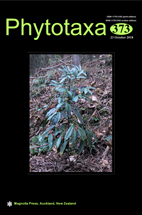Abstract
A new wood-inhabiting fungus, Phlebia ailaoshanensis, is proposed based on a combination of morphological features and molecular evidence. The species is characterized by an annual growth habit, resupinate basidiocarps with tuberculate to phlebioid hymenial surface, a monomitic hyphal system with slightly thick-walled generative hyphae bearing simple septa, IKI–, CB– and ellipsoid, hyaline, thin-walled, smooth, IKI–, CB– basidiospores measuring as 5.7–8.5 × 3–4.3 µm. Sequences of ITS and LSU nrRNA gene regions of the studied samples were generated, and phylogenetic analyses were performed with maximum likelihood, maximum parsimony and bayesian inference methods. The phylogenetic analyses based on molecular data of ITS+nLSU sequences showed that P. ailaoshanensis belonged to the Meruliaceae and nested into the phlebioid clade. Further investigation was obtained for more representative taxa in the Phlebia based on ITS+nLSU sequences, in which the result demonstrated that the species P. ailaoshanensis formed a monophyletic lineage with a strong support (100% BS, 100% BP, 1.00 BPP) and then grouped with P. acanthocystis, P. chrysocreas, P. ludoviciana, P. subcretacea and P. uda.

